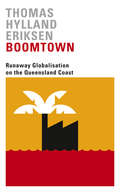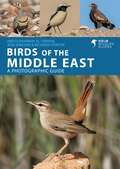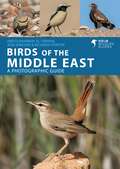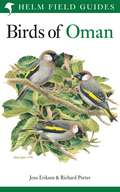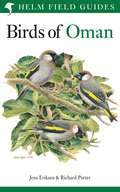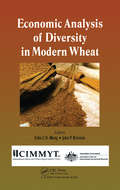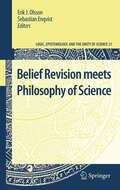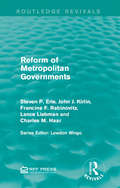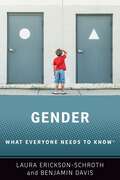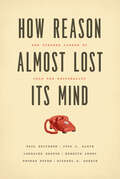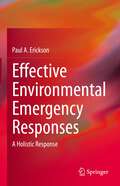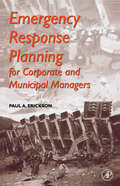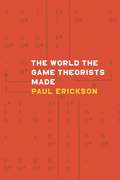- Table View
- List View
Boomtown: Runaway Globalisation on the Queensland Coast
by Thomas Hylland EriksenSitting next to the Great Barrier Reef, marinated in coal and gas, the industrial boomtown of Gladstone, Australia embodies many of the contradictions of the 'overheated' world: prosperous yet polluted; growing and developing yet always on the precipice of uncertainty.*BR**BR*Capturing Gladstone at the peak of its accelerated growth in 2013-14, Thomas Hylland Eriksen dissects the boomtown phenomenon in all its profound ambivalence. Based on ethnographic fieldwork, the book explores the tensions and resentments surrounding migrant workers, and examines local identity, family life, infrastructure and local services.*BR**BR*Writ large in Boomtown are the clashes of scale at the heart of the town's contradictions - where the logic of big industry and the state compete with that of the individual, local communities and ecology, revealing the current crisis of political legitimacy across the world.
Birds of the Middle East (Helm Wildlife Guides)
by Jens Eriksen Richard Porter Abdulrahman Al-SirhanThe Middle East has a wonderfully broad and diverse avifauna, featuring a host of wintering and passage migrants, enigmatic and sometimes colourful breeders, and even a few endemics that occur nowhere else. The perfect companion for any wildlife-friendly visitor, Birds of the Middle East provides photographic coverage of more than 320 species that regularly occur in the region. Concise text for each species includes information on identification, songs and calls, behaviour, distribution and habitat, with each photo having been carefully selected to guide identification. A guide to the best birdwatching sites in the Middle East is also included. Portable yet authoritative, this is the perfect guide for travellers and birdwatchers visiting this spectacular and bird-rich slice of western Asia.
Birds of the Middle East (Helm Wildlife Guides)
by Jens Eriksen Richard Porter Abdulrahman Al-SirhanThe Middle East has a wonderfully broad and diverse avifauna, featuring a host of wintering and passage migrants, enigmatic and sometimes colourful breeders, and even a few endemics that occur nowhere else. The perfect companion for any wildlife-friendly visitor, Birds of the Middle East provides photographic coverage of more than 320 species that regularly occur in the region. Concise text for each species includes information on identification, songs and calls, behaviour, distribution and habitat, with each photo having been carefully selected to guide identification. A guide to the best birdwatching sites in the Middle East is also included. Portable yet authoritative, this is the perfect guide for travellers and birdwatchers visiting this spectacular and bird-rich slice of western Asia.
Birds of Oman (Helm Field Guides)
by Jens Eriksen Richard PorterWith its unique blend of Western Palearctic, Oriental and Afrotropical components, and lying on a migratory crossroads, Oman is a jewel of the Middle East. This is the first comprehensive field guide to the birds of this fascinating and welcoming country. All 528 species on the Oman Bird List are featured on the 116 colour plates, illustrating many of the distinct plumages and races, plus a few non-naturalised escapes. Species accounts cover key identification features - including habitat and voice - with colour maps showing the breeding, wintering and migration distributions for all regularly occurring species.
Birds of Oman (Helm Field Guides)
by Jens Eriksen Richard PorterWith its unique blend of Western Palearctic, Oriental and Afrotropical components, and lying on a migratory crossroads, Oman is a jewel of the Middle East. This is the first comprehensive field guide to the birds of this fascinating and welcoming country. All 528 species on the Oman Bird List are featured on the 116 colour plates, illustrating many of the distinct plumages and races, plus a few non-naturalised escapes. Species accounts cover key identification features - including habitat and voice - with colour maps showing the breeding, wintering and migration distributions for all regularly occurring species.
Bio-Geo Interactions in Metal-Contaminated Soils (Soil Biology #31)
by Erika Kothe and Ajit VarmaMetal contamination is an increasing ecological and eco-toxicological risk. Understanding the processes involved in metal mobilization, sorption and mineralization in soils are key features for soil bioremediation.Following an introduction to the physical, chemical and biological components of contaminated soils, various chapters address the interactions of soil, microorganisms, plants and the water phase necessary to transfer metals into biological systems. These include topics such as potential hazards at mining sites; rare earth elements in biotic and abiotic acidic systems; manganese redox reactions; biomineralisation, uranium in seepage water; metal-resistant streptomycetes; mycorrhiza in re-forestation; metal (hyper)accummulation in plants; microbial metal uptake; and their potential for bioremediation.This book will be of interest to soil biologists, geologists and chemists, researchers and graduate students, as well as consulting companies and small enterprises involved in bioremediation.
Economic Analysis of Diversity in Modern Wheat
by Erika C.H. Meng and John P. BrennanScientific breeding in the twentieth century greatly accelerated wheat`s evolution, producing high-yielding varieties that helped avoid famine in many developing countries. Emerging scientific tools hold promise for identifying and tapping new, useful genetic diversity within wheat`s primary and secondary gene pools and, through genetic engineering, beyond.The book describes generally how policies affect wheat genetic diversity; it looks at historical changes in wheat genetic diversity, as policy and priorities have evolved; it identifies factors that explain changes and differences in spatial diversity; and finally, it analyzes the productivity impacts of changes in diversity. Chapters define various types of crop genetic diversity and ways to measure them, framing the definitions and metrics in the contexts for which they are most relevant.
Biosimulation in Biomedical Research, Health Care and Drug Development
by Erik Mosekilde, Olga Sosnovtseva and Amin Rostami-HodjeganBiosimulation is an approach to biomedical research and the treatment of patients in which computer modeling goes hand in hand with experimental and clinical work. Constructed models are used to interpret experimental results and to accumulate information from experiment to experiment.This book explains the concepts used in the modeling of biological phenomena and goes on to present a series of well-documented models of the regulation of various genetic, cellular and physiological processes. The way how the use of computer models allows optimization of cancer treatment for individual patients is discussed and models of interacting nerve cells that can be used to design new treatments for patients with Parkinson's disease are explained. Furthermore this volume provides an overview on the use of models in industry, and presents the view of regulatory agencies on the topic.
Belief Revision meets Philosophy of Science (Logic, Epistemology, and the Unity of Science #21)
by Erik J. Olsson and Sebastian EnqvistBelief revision theory and philosophy of science both aspire to shed light on the dynamics of knowledge – on how our view of the world changes (typically) in the light of new evidence. Yet these two areas of research have long seemed strangely detached from each other, as witnessed by the small number of cross-references and researchers working in both domains. One may speculate as to what has brought about this surprising, and perhaps unfortunate, state of affairs. One factor may be that while belief revision theory has traditionally been pursued in a bottom- up manner, focusing on the endeavors of single inquirers, philosophers of science, inspired by logical empiricism, have tended to be more interested in science as a multi-agent or agent-independent phenomenon.
Reform of Metropolitan Governments (Routledge Revivals)
by Steven P. Erie John J. Kirlin Francine F. Rabinovitz Lance Liebman Charles M. HaarOriginally published in 1972, this study aims to explore governmental interaction with people and publics interests and institutions in Metropolitan America. These papers discuss issues of how governance can be improved and the federal role in Metropolitanism as well as suggesting ways in which political reform can help. This title will be of interest to students of Environmental Economics and professionals.
Reform of Metropolitan Governments (Routledge Revivals)
by Steven P. Erie John J. Kirlin Francine F. Rabinovitz Lance Liebman Charles M. HaarOriginally published in 1972, this study aims to explore governmental interaction with people and publics interests and institutions in Metropolitan America. These papers discuss issues of how governance can be improved and the federal role in Metropolitanism as well as suggesting ways in which political reform can help. This title will be of interest to students of Environmental Economics and professionals.
Gender: What Everyone Needs to Know® (What Everyone Needs to Know)
by Laura Erickson-Schroth Benjamin DavisThe term "gender" was first distinguished from "sex" in the 1950s when psychologists began to discuss the idea of "gender roles," behaviors and responsibilities given to people by a society rather than flowing from their biology. Since then, leaders across disciplines have sought to better understand the roles of biology, psychology, and culture on gender. New language has emerged alongside rich scientific inquiry and research. Increased visibility of transgender and nonbinary communities has brought awareness to a range of gender diverse experiences, while legal battles, wage disparities, and health inequities continue to prove gender's relevancy in today's world. In this book, Laura Erickson-Schroth and Benjamin Davis guide readers through the knowns and unknowns of gender, asking questions such as: What is the difference between sex, gender identity, and gender expression? Were ancient societies matriarchal? How different are male and female brains, really? What role does language play in the ways we think about gender? What do we know about sex and gender in non-human species? What are the current frontiers in gender equality? Gender: What Everyone Needs to Know® is an easy-to-read guide that takes readers on a much-needed tour of perspectives on gender and identity in the 21st century. The book is written in a question-and-answer format, and Erickson-Schroth and Davis cover topics such as current definitions; the history of gender as concept; theÂrole of biology, psychology, and culture on gender; and gender norms over time and across the globe.
GENDER WENK C: What Everyone Needs to Know® (What Everyone Needs to Know)
by Laura Erickson-Schroth Benjamin DavisThe term "gender" was first distinguished from "sex" in the 1950s when psychologists began to discuss the idea of "gender roles," behaviors and responsibilities given to people by a society rather than flowing from their biology. Since then, leaders across disciplines have sought to better understand the roles of biology, psychology, and culture on gender. New language has emerged alongside rich scientific inquiry and research. Increased visibility of transgender and nonbinary communities has brought awareness to a range of gender diverse experiences, while legal battles, wage disparities, and health inequities continue to prove gender's relevancy in today's world. In this book, Laura Erickson-Schroth and Benjamin Davis guide readers through the knowns and unknowns of gender, asking questions such as: What is the difference between sex, gender identity, and gender expression? Were ancient societies matriarchal? How different are male and female brains, really? What role does language play in the ways we think about gender? What do we know about sex and gender in non-human species? What are the current frontiers in gender equality? Gender: What Everyone Needs to Know® is an easy-to-read guide that takes readers on a much-needed tour of perspectives on gender and identity in the 21st century. The book is written in a question-and-answer format, and Erickson-Schroth and Davis cover topics such as current definitions; the history of gender as concept; theÂrole of biology, psychology, and culture on gender; and gender norms over time and across the globe.
How Reason Almost Lost Its Mind: The Strange Career of Cold War Rationality
by Paul Erickson Judy L. Klein Lorraine Daston Rebecca Lemov Thomas Sturm Michael D. GordinIn the United States at the height of the Cold War, roughly between the end of World War II and the early 1980s, a new project of redefining rationality commanded the attention of sharp minds, powerful politicians, wealthy foundations, and top military brass. Its home was the human sciences—psychology, sociology, political science, and economics, among others—and its participants enlisted in an intellectual campaign to figure out what rationality should mean and how it could be deployed. How Reason Almost Lost Its Mind brings to life the people—Herbert Simon, Oskar Morgenstern, Herman Kahn, Anatol Rapoport, Thomas Schelling, and many others—and places, including the RAND Corporation, the Center for Advanced Study in the Behavioral Sciences, the Cowles Commission for Research and Economics, and the Council on Foreign Relations, that played a key role in putting forth a “Cold War rationality.” Decision makers harnessed this picture of rationality—optimizing, formal, algorithmic, and mechanical—in their quest to understand phenomena as diverse as economic transactions, biological evolution, political elections, international relations, and military strategy. The authors chronicle and illuminate what it meant to be rational in the age of nuclear brinkmanship.
How Reason Almost Lost Its Mind: The Strange Career of Cold War Rationality
by Paul Erickson Judy L. Klein Lorraine Daston Rebecca Lemov Thomas Sturm Michael D. GordinIn the United States at the height of the Cold War, roughly between the end of World War II and the early 1980s, a new project of redefining rationality commanded the attention of sharp minds, powerful politicians, wealthy foundations, and top military brass. Its home was the human sciences—psychology, sociology, political science, and economics, among others—and its participants enlisted in an intellectual campaign to figure out what rationality should mean and how it could be deployed. How Reason Almost Lost Its Mind brings to life the people—Herbert Simon, Oskar Morgenstern, Herman Kahn, Anatol Rapoport, Thomas Schelling, and many others—and places, including the RAND Corporation, the Center for Advanced Study in the Behavioral Sciences, the Cowles Commission for Research and Economics, and the Council on Foreign Relations, that played a key role in putting forth a “Cold War rationality.” Decision makers harnessed this picture of rationality—optimizing, formal, algorithmic, and mechanical—in their quest to understand phenomena as diverse as economic transactions, biological evolution, political elections, international relations, and military strategy. The authors chronicle and illuminate what it meant to be rational in the age of nuclear brinkmanship.
How Reason Almost Lost Its Mind: The Strange Career of Cold War Rationality
by Paul Erickson Judy L. Klein Lorraine Daston Rebecca Lemov Thomas Sturm Michael D. GordinIn the United States at the height of the Cold War, roughly between the end of World War II and the early 1980s, a new project of redefining rationality commanded the attention of sharp minds, powerful politicians, wealthy foundations, and top military brass. Its home was the human sciences—psychology, sociology, political science, and economics, among others—and its participants enlisted in an intellectual campaign to figure out what rationality should mean and how it could be deployed. How Reason Almost Lost Its Mind brings to life the people—Herbert Simon, Oskar Morgenstern, Herman Kahn, Anatol Rapoport, Thomas Schelling, and many others—and places, including the RAND Corporation, the Center for Advanced Study in the Behavioral Sciences, the Cowles Commission for Research and Economics, and the Council on Foreign Relations, that played a key role in putting forth a “Cold War rationality.” Decision makers harnessed this picture of rationality—optimizing, formal, algorithmic, and mechanical—in their quest to understand phenomena as diverse as economic transactions, biological evolution, political elections, international relations, and military strategy. The authors chronicle and illuminate what it meant to be rational in the age of nuclear brinkmanship.
How Reason Almost Lost Its Mind: The Strange Career of Cold War Rationality
by Paul Erickson Judy L. Klein Lorraine Daston Rebecca Lemov Thomas Sturm Michael D. GordinIn the United States at the height of the Cold War, roughly between the end of World War II and the early 1980s, a new project of redefining rationality commanded the attention of sharp minds, powerful politicians, wealthy foundations, and top military brass. Its home was the human sciences—psychology, sociology, political science, and economics, among others—and its participants enlisted in an intellectual campaign to figure out what rationality should mean and how it could be deployed. How Reason Almost Lost Its Mind brings to life the people—Herbert Simon, Oskar Morgenstern, Herman Kahn, Anatol Rapoport, Thomas Schelling, and many others—and places, including the RAND Corporation, the Center for Advanced Study in the Behavioral Sciences, the Cowles Commission for Research and Economics, and the Council on Foreign Relations, that played a key role in putting forth a “Cold War rationality.” Decision makers harnessed this picture of rationality—optimizing, formal, algorithmic, and mechanical—in their quest to understand phenomena as diverse as economic transactions, biological evolution, political elections, international relations, and military strategy. The authors chronicle and illuminate what it meant to be rational in the age of nuclear brinkmanship.
How Reason Almost Lost Its Mind: The Strange Career of Cold War Rationality
by Paul Erickson Judy L. Klein Lorraine Daston Rebecca Lemov Thomas Sturm Michael D. GordinIn the United States at the height of the Cold War, roughly between the end of World War II and the early 1980s, a new project of redefining rationality commanded the attention of sharp minds, powerful politicians, wealthy foundations, and top military brass. Its home was the human sciences—psychology, sociology, political science, and economics, among others—and its participants enlisted in an intellectual campaign to figure out what rationality should mean and how it could be deployed. How Reason Almost Lost Its Mind brings to life the people—Herbert Simon, Oskar Morgenstern, Herman Kahn, Anatol Rapoport, Thomas Schelling, and many others—and places, including the RAND Corporation, the Center for Advanced Study in the Behavioral Sciences, the Cowles Commission for Research and Economics, and the Council on Foreign Relations, that played a key role in putting forth a “Cold War rationality.” Decision makers harnessed this picture of rationality—optimizing, formal, algorithmic, and mechanical—in their quest to understand phenomena as diverse as economic transactions, biological evolution, political elections, international relations, and military strategy. The authors chronicle and illuminate what it meant to be rational in the age of nuclear brinkmanship.
How Reason Almost Lost Its Mind: The Strange Career of Cold War Rationality
by Paul Erickson Judy L. Klein Lorraine Daston Rebecca Lemov Thomas Sturm Michael D. GordinIn the United States at the height of the Cold War, roughly between the end of World War II and the early 1980s, a new project of redefining rationality commanded the attention of sharp minds, powerful politicians, wealthy foundations, and top military brass. Its home was the human sciences—psychology, sociology, political science, and economics, among others—and its participants enlisted in an intellectual campaign to figure out what rationality should mean and how it could be deployed. How Reason Almost Lost Its Mind brings to life the people—Herbert Simon, Oskar Morgenstern, Herman Kahn, Anatol Rapoport, Thomas Schelling, and many others—and places, including the RAND Corporation, the Center for Advanced Study in the Behavioral Sciences, the Cowles Commission for Research and Economics, and the Council on Foreign Relations, that played a key role in putting forth a “Cold War rationality.” Decision makers harnessed this picture of rationality—optimizing, formal, algorithmic, and mechanical—in their quest to understand phenomena as diverse as economic transactions, biological evolution, political elections, international relations, and military strategy. The authors chronicle and illuminate what it meant to be rational in the age of nuclear brinkmanship.
Effective Environmental Emergency Responses: A Holistic Response
by Paul A. EricksonThis book focuses on the variety of subsequent consequences that may follow the conclusion of the immediate emergency response effort, consequences that require multi-disciplinary efforts and most likely may require a revamping of the historical interplay of national and other political authorities. The book is essentially a critique of contemporary emergency response which, in both the public perception and, unfortunately, in the mind-set of many practicing professionals emphasizes an emergency as a singular event. It is a mistaken view: an emergency is actually a sequence of multiple, singular events that unfold over time, sometimes measured in days and weeks and, most often, in months, years and decades. This book focuses on the need, in the current and recent past generation to revamp our thinking about planning for and responding comprehensively to those periodic disruptions to daily routine we call "emergencies".
Emergency Response Planning: For Corporate and Municipal Managers
by Paul A. EricksonEmergencies wreak havoc on businesses and governments on a daily basis. Whether it is a hurricane pounding a coastal community, a terrorist attack on a company's headquarters, or a hazardous chemical spill at a local school, the results can be loss of life, health, and property. How can you prevent or reduce the effects of such occurrences? By planning ahead.Emergency Response Planning is designed to help corporate and municipal managers quickly understand their roles in proactive and reactive emergency management. Author Paul Erickson shows how to develop partnerships with federal, state, and local government agencies, as well as community groups in order to prevent, prepare for, and respond to natural disasters and manmade emergencies.Emergency Response Planning provides essential information to help you comply with government regulations, design an emergency response plan, train personnel, use the proper safety equipment, safeguard information systems, and resume normal operations after an emergency as quickly as possible. It will also help consultants design emergency response plans for their clients, and provide practical information for students studying business continuity and emergency issues.Is an important resource for: Corporate and municipal managers involved in emergency managementOrganizational safety committee membersIndustrial health and safety consultants and their clientsGraduate and undergraduate students studying emergency response issuesOutlines both proactive and reactive strategies to reduce risk to human life, health, and propertyDescribes how to form effective partnerships with government agencies and community support resourcesDefines the roles of corporate and municipal managers, planning team members, and response personnelExplains regulations and guidelines from key agencies including OSHA, EPA, FEMA, CDC, US Fire Administration, and moreMakes information easy to understand with dozens of tables, illustrations, and appendices
The World the Game Theorists Made: Game Theory And Cold War Culture
by Paul EricksonIn recent decades game theory—the mathematics of rational decision-making by interacting individuals—has assumed a central place in our understanding of capitalist markets, the evolution of social behavior in animals, and even the ethics of altruism and fairness in human beings. With game theory’s ubiquity, however, has come a great deal of misunderstanding. Critics of the contemporary social sciences view it as part of an unwelcome trend toward the marginalization of historicist and interpretive styles of inquiry, and many accuse its proponents of presenting a thin and empirically dubious view of human choice. The World the Game Theorists Made seeks to explain the ascendency of game theory, focusing on the poorly understood period between the publication of John von Neumann and Oscar Morgenstern’s seminal Theory of Games and Economic Behavior in 1944 and the theory’s revival in economics in the 1980s. Drawing on a diverse collection of institutional archives, personal correspondence and papers, and interviews, Paul Erickson shows how game theory offered social scientists, biologists, military strategists, and others a common, flexible language that could facilitate wide-ranging thought and debate on some of the most critical issues of the day.
The World the Game Theorists Made: Game Theory And Cold War Culture
by Paul EricksonIn recent decades game theory—the mathematics of rational decision-making by interacting individuals—has assumed a central place in our understanding of capitalist markets, the evolution of social behavior in animals, and even the ethics of altruism and fairness in human beings. With game theory’s ubiquity, however, has come a great deal of misunderstanding. Critics of the contemporary social sciences view it as part of an unwelcome trend toward the marginalization of historicist and interpretive styles of inquiry, and many accuse its proponents of presenting a thin and empirically dubious view of human choice. The World the Game Theorists Made seeks to explain the ascendency of game theory, focusing on the poorly understood period between the publication of John von Neumann and Oscar Morgenstern’s seminal Theory of Games and Economic Behavior in 1944 and the theory’s revival in economics in the 1980s. Drawing on a diverse collection of institutional archives, personal correspondence and papers, and interviews, Paul Erickson shows how game theory offered social scientists, biologists, military strategists, and others a common, flexible language that could facilitate wide-ranging thought and debate on some of the most critical issues of the day.
The World the Game Theorists Made
by Paul EricksonIn recent decades game theory—the mathematics of rational decision-making by interacting individuals—has assumed a central place in our understanding of capitalist markets, the evolution of social behavior in animals, and even the ethics of altruism and fairness in human beings. With game theory’s ubiquity, however, has come a great deal of misunderstanding. Critics of the contemporary social sciences view it as part of an unwelcome trend toward the marginalization of historicist and interpretive styles of inquiry, and many accuse its proponents of presenting a thin and empirically dubious view of human choice. The World the Game Theorists Made seeks to explain the ascendency of game theory, focusing on the poorly understood period between the publication of John von Neumann and Oscar Morgenstern’s seminal Theory of Games and Economic Behavior in 1944 and the theory’s revival in economics in the 1980s. Drawing on a diverse collection of institutional archives, personal correspondence and papers, and interviews, Paul Erickson shows how game theory offered social scientists, biologists, military strategists, and others a common, flexible language that could facilitate wide-ranging thought and debate on some of the most critical issues of the day.
The World the Game Theorists Made
by Paul EricksonIn recent decades game theory—the mathematics of rational decision-making by interacting individuals—has assumed a central place in our understanding of capitalist markets, the evolution of social behavior in animals, and even the ethics of altruism and fairness in human beings. With game theory’s ubiquity, however, has come a great deal of misunderstanding. Critics of the contemporary social sciences view it as part of an unwelcome trend toward the marginalization of historicist and interpretive styles of inquiry, and many accuse its proponents of presenting a thin and empirically dubious view of human choice. The World the Game Theorists Made seeks to explain the ascendency of game theory, focusing on the poorly understood period between the publication of John von Neumann and Oscar Morgenstern’s seminal Theory of Games and Economic Behavior in 1944 and the theory’s revival in economics in the 1980s. Drawing on a diverse collection of institutional archives, personal correspondence and papers, and interviews, Paul Erickson shows how game theory offered social scientists, biologists, military strategists, and others a common, flexible language that could facilitate wide-ranging thought and debate on some of the most critical issues of the day.
